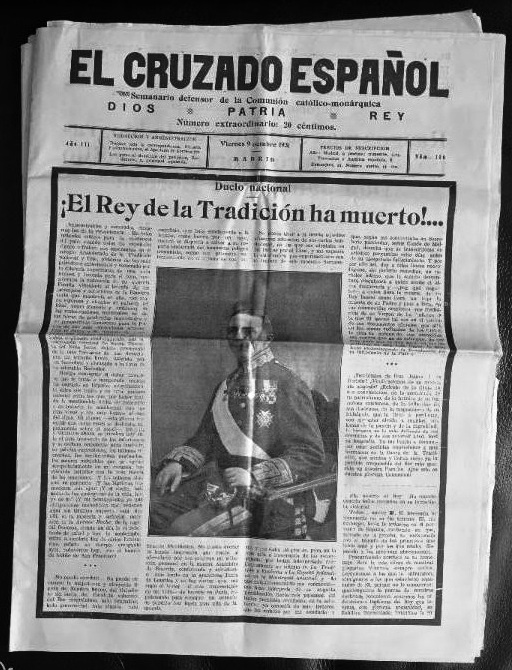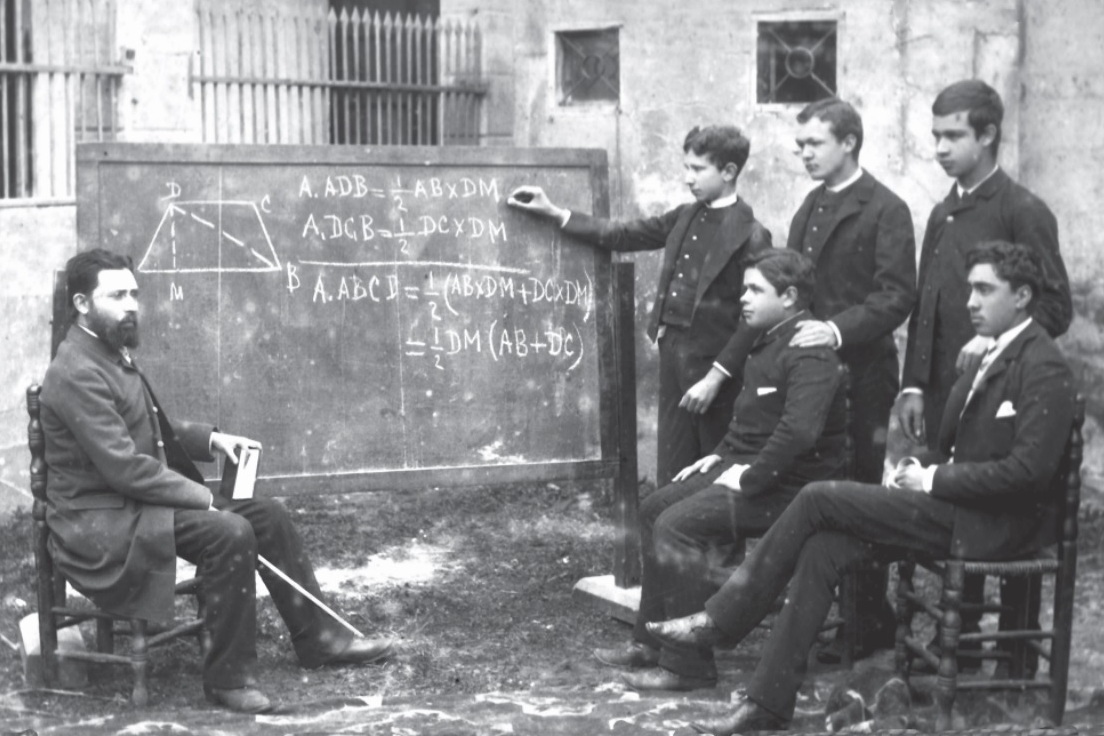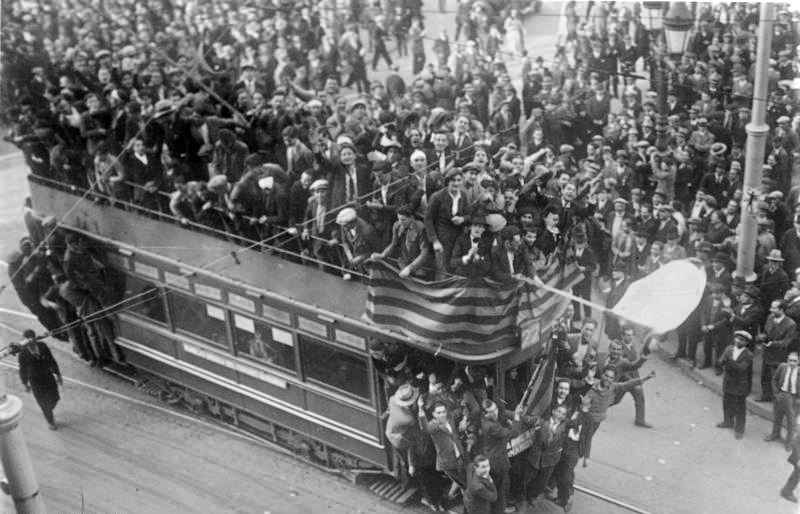|
Carloctavismo
Carloctavismo (; the name appears also as ''carlosoctavismo'', ''carlooctavismo'', ''carlos-octavismo'', ''carlo-octavismo'', or ''octavismo'') is a branch of Carlism, particularly active in the 1943–1953 period. In terms of dynastical allegiances it advanced the claim to the Spanish throne of Carlos Pio de Habsburgo-Lorena y de Borbón, styled as Carlos VIII, and his relatives. In terms of political line it collaborated very closely with Francoism. Antecedents (1932–1943) During a hundred years of its history Carlism was headed by six successive claimants with clear heritage rights; however, in the early 1930s it was evident that the dynasty would soon extinguish. The pretender, Don Alfonso Carlos, was 82 when assuming the claim in 1931 and had no issue. For the first time ever the Carlists were neither clear who would be their next king nor how the issue was to be tackled. Don Alfonso Carlos seemed leaning towards a compromise with the Alfonsists, engineered though not se ... [...More Info...] [...Related Items...] OR: [Wikipedia] [Google] [Baidu] |
Jesús Cora Y Lira
Jesús de Cora y Lira, 1st Count of Cora y Lira (1890–1969) was a Spanish soldier and a Carlist politician. In the navy juridical arm he rose to general auditor, a rank equivalent to counter-admiral. He is known mostly as political leader of Carloctavismo, a branch of Carlism which during early Francoism advocated a claim to the Spanish throne raised by Carlos Pio Habsburgo-Lorena y Borbón. Family and youth Along his paternal line Jesús Cora y Lira was descendant to an established, noble Galician family. The Coras have been for centuries related to the province of Lugo and the comarca of Viveiro. Their first representative was noted in the 15th century and some grew to local regidores; also during late Restauración a distant Jesús' relative, Purificación de Cora y Más Villafuerte, apart from setting up a local daily ''El Progreso'' served also as a civil governor. Jesús' great-grandfather, José María de Cora Aguiar y Maseda, was a military and participated in ... [...More Info...] [...Related Items...] OR: [Wikipedia] [Google] [Baidu] |
Carlism
Carlism ( eu, Karlismo; ca, Carlisme; ; ) is a Traditionalist and Legitimist political movement in Spain aimed at establishing an alternative branch of the Bourbon dynasty – one descended from Don Carlos, Count of Molina (1788–1855) – on the Spanish throne. The movement was founded in consequence of a dispute over the succession laws and widespread dissatisfaction with the Alfonsine line of the House of Bourbon. It was at its strongest in the 1830s but experienced a revival following Spain's defeat in the Spanish–American War in 1898, when Spain lost its last remaining significant overseas territories of the Philippines, Cuba, Guam, and Puerto Rico to the United States. Carlism was a significant force in Spanish politics from 1833 until the end of the Francoist regime in 1975. In this capacity, it was the cause of the Carlist Wars of the 19th century and an important factor in the Spanish Civil War in the 1930s. Today, Carlists are a minor party. Origins The ... [...More Info...] [...Related Items...] OR: [Wikipedia] [Google] [Baidu] |
Infanta Blanca Of Spain
Infanta Blanca of Spain (7 September 1868 – 25 October 1949) was the eldest child of Carlos, Duke of Madrid, Carlist claimant to the throne of Spain and his wife Princess Margherita of Bourbon-Parma. Blanca was a member of the House of Bourbon and - according to the Carlists - an Infanta of Spain by birth. In 1889 she married Archduke Leopold Salvator of Austria. The couple had ten children. The family left Austria after the end of the Monarchy and finally settled in Barcelona. When the male line of Blanca's family died out at the death of her uncle, Alfonso Carlos, Duke of San Jaime, some of the Carlists recognized her as the legitimate heiress to the Spanish throne. Early life Infanta Blanca of Spain was born in Graz, Styria, Austria-Hungary, the eldest child of Carlos, Duke of Madrid, the Carlist claimant to the throne of Spain under the name Carlos VII and of his wife Princess Margherita of Bourbon-Parma. At the time of her birth, her parents were living in Styri ... [...More Info...] [...Related Items...] OR: [Wikipedia] [Google] [Baidu] |
Archduke Karl Pius Of Austria, Prince Of Tuscany
Archduke Karl Pius of Austria, Prince Royal of Hungary and Bohemia, Prince of Tuscany (4 December 1909 – 24 December 1953), known as Carlos Pío de Habsburgo-Lorena y de Borbón in Spanish, was a member of the Tuscan branch of the Imperial House of Habsburg and a Carlist claimant to the throne of Spain under the assumed name of "Carlos VIII". He was the tenth and youngest child of Archduke Leopold Salvator, Prince of Tuscany and Infanta Blanca of Spain. Early life Karl was born in Vienna, Austria-Hungary, the youngest son of Archduke Leopold Salvator of Austria (1863–1931) and of his wife Blanca de Borbón y de Borbón-Parma (1868–1949). His mother was the eldest daughter of Carlos, Duke of Madrid, Carlist claimant to the throne of Spain. Karl was given the baptismal names ''Carolus Pius Maria Adelgonda Blanka Leopoldus Ignatius Raphael Michael Salvator Chrillus Angelus Barbara''. His godparents were Pope Pius X and the Countess of Bardi. Karl grew up in the Palais ... [...More Info...] [...Related Items...] OR: [Wikipedia] [Google] [Baidu] |
Melchor Ferrer Dalmau
Melchor Ferrer Dalmau (1888–1965) was a Spanish historian and a Carlist militant. He is known mostly as principal author of a massive, 30-volume series titled ''Historia del tradicionalismo español'', considered fundamental work of reference for any student of Carlism. Ferrer is recognized also as "periodista" (journalist), chief editor of a national and a few local traditionalist dailies and contributor to a number of others. Politically he maintained a low profile, though periodically he was member of the party executive, and during internal party strife of the early 1960s his support might have tipped the balance in favor of the progressist faction. Family and youth Ferrer counts among the oldest and most common names in Catalonia; one family lived in the town of Mataró, where in the 14th century it was first noted when turning from "lo ferrer" to "lo Fferrer". They grew into prominence as traders and bankers in the 15th century, dubbed "primera familia de patricis de Mata ... [...More Info...] [...Related Items...] OR: [Wikipedia] [Google] [Baidu] |
Alfonso Carlos, Duke Of San Jaime
Infante Alfonso Carlos of Spain, Duke of San Jaime (Alfonso Carlos Fernando José Juan Pío; 12 September 1849, in London – 29 September 1936, in Vienna) was the Carlist claimant to the throne of Spain under the name Alfonso Carlos I; some French Legitimists declared him also the king of France, though Alfonso never officially endorsed these claims. In 1870 and in the ranks of the papal troops, he defended Rome against the Italian Army. In 1872–1874, he commanded sections of the front during the Third Carlist War. Between the mid-1870s and the early 1930s, he remained withdrawn into privacy, living in his residences in Austria. His public engagements were related to the buildup of an international league against dueling. Upon the unexpected death of his nephew Infante Jaime, Duke of Madrid in 1931, he inherited the Spanish and French monarchical claims. As an octagenarian he dedicated himself to development of Carlist structures in Spain. He led the movement into the anti- ... [...More Info...] [...Related Items...] OR: [Wikipedia] [Google] [Baidu] |
Pact Of Territet
Pact of Territet ( es, El Pacto de Territet) was an attempt to mend the long-standing dynastic feud between two Spanish House of Bourbon, Borbón branches and their supporters, known as the Alfonsism, Alfonsists and the Carlism, Carlists. In September 1931 it was agreed between two competitive exiled claimants, posing as Alfonso XIII and Infante Jaime, Duke of Madrid, Jaime III. The deal envisioned that a new Spanish constituent assembly would pronounce who should be the king, and both pretenders pledged to accept the verdict. It was also tacitly understood that the following king should be Infante Juan, Count of Barcelona, Juan de Borbón y Battenberg, descendant of the Alfonsist branch but supposed to embrace Traditionalism (Spain), Carlist political principles. Following unexpected death of Jaime III the agreement was questioned by his Carlist successor, posing as Infante Alfonso Carlos, Duke of San Jaime, Alfonso Carlos I; he demanded further declarations on part of the Alfonsis ... [...More Info...] [...Related Items...] OR: [Wikipedia] [Google] [Baidu] |
Vienna
en, Viennese , iso_code = AT-9 , registration_plate = W , postal_code_type = Postal code , postal_code = , timezone = CET , utc_offset = +1 , timezone_DST = CEST , utc_offset_DST = +2 , blank_name = Vehicle registration , blank_info = W , blank1_name = GDP , blank1_info = € 96.5 billion (2020) , blank2_name = GDP per capita , blank2_info = € 50,400 (2020) , blank_name_sec1 = HDI (2019) , blank_info_sec1 = 0.947 · 1st of 9 , blank3_name = Seats in the Federal Council , blank3_info = , blank_name_sec2 = GeoTLD , blank_info_sec2 = .wien , website = , footnotes = , image_blank_emblem = Wien logo.svg , blank_emblem_size = Vienna ( ; german: Wien ; ba ... [...More Info...] [...Related Items...] OR: [Wikipedia] [Google] [Baidu] |
Barcelona
Barcelona ( , , ) is a city on the coast of northeastern Spain. It is the capital and largest city of the autonomous community of Catalonia, as well as the second most populous municipality of Spain. With a population of 1.6 million within city limits,Barcelona: Población por municipios y sexo – Instituto Nacional de Estadística. (National Statistics Institute) its urban area extends to numerous neighbouring municipalities within the and is home to around 4.8 million people, making it the [...More Info...] [...Related Items...] OR: [Wikipedia] [Google] [Baidu] |
Sanjurjada
Sanjurjada () was a military coup staged in Spain on August 10, 1932. It was aimed at toppling the government but not necessarily at toppling the Republic. Following brief clashes it was easily suppressed in Madrid. Hardly any action was recorded elsewhere except Seville, where local rebel commander general José Sanjurjo took control for some 24 hours but acknowledged defeat when faced with resolute governmental response. Due to his brief success and attention given during following trials, the entire coup has been later named after him. Background Spanish military greeted the advent of the Republic with little enthusiasm, though also with no particular hostility. The officer corps tended to be rather monarchist than republican and rather conservative than liberal, but following last years of the dictatorship, which had compromised and discredited the army, most military men preferred to stay clear of politics. It was only when the new regime was set on a firmly leftward course a ... [...More Info...] [...Related Items...] OR: [Wikipedia] [Google] [Baidu] |
Zaragoza
Zaragoza, also known in English as Saragossa,''Encyclopædia Britannica'"Zaragoza (conventional Saragossa)" is the capital city of the Zaragoza Province and of the autonomous community of Aragon, Spain. It lies by the Ebro river and its tributaries, the Huerva and the Gállego, roughly in the center of both Aragon and the Ebro basin. On 1 January 2021 the population of the municipality of Zaragoza was 675,301, (the fifth most populated in Spain) on a land area of . The population of the metropolitan area was estimated in 2006 at 783,763 inhabitants. The municipality is home to more than 50 percent of the Aragonese population. The city lies at an elevation of about above sea level. Zaragoza hosted Expo 2008 in the summer of 2008, a world's fair on water and sustainable development. It was also a candidate for the European Capital of Culture in 2012. The city is famous for its folklore, local cuisine, and landmarks such as the Basílica del Pilar, La Seo Cathedral and the A ... [...More Info...] [...Related Items...] OR: [Wikipedia] [Google] [Baidu] |









